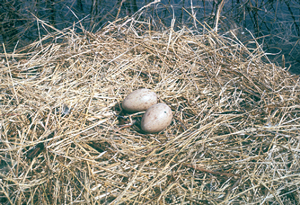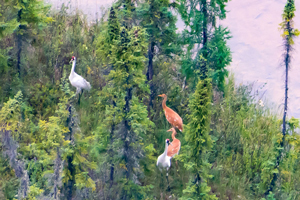
Photo : Parks Canada / Klaus Nigge
Back from the Brink of Extinction…
Wood Buffalo National Park

Photo: Parks Canada
By the early 1940’s there were only 22 wild whooping cranes left in the world. Thanks to the discovery of the nesting area in Wood Buffalo National Park in 1954, a source of wild eggs was now available for use in captive breeding. The first wild egg collection occurred in 1966 under the direction of renowned Canadian Wildlife Service biologist Ernie Kuyt. Flown in by helicopter, Kuyt and his team waded through the wetlands to collect the eggs, carrying them in a sock and never taking more than one from a nest. The collected eggs were placed in a portable incubator which was kept warm with hot water bottles, and flown to the Patuxent Wildlife Research Center near Laurel, Maryland.
The egg collections continued until 1998. During this period, a total of 242 eggs were sent to the various captive breeding facilities (including 4 eggs to the Calgary Zoo in 1994 and another 2 eggs in 1998, as well as one live chick to the Calgary Zoo in 1999). An additional 215 eggs were sent to Grey’s Lake in Idaho for use in a cross-fostering experiment with wild sandhill cranes.
In the ensuing years, much monitoring and research occurred. One initiative that occurred in the park was a color-banding project, led by Canadian Wildlife Service’s Ernie Kuyt from 1977 – 1988. A radio-tracking project also occurred from 1981 to 1983.

Photo: Parks Canada / John McKinnon
Thanks to the International Whooping Crane Recovery Program’s many decades of research, captive breeding, reintroduction efforts in the United States, and ongoing protection of the wild Wood Buffalo – Aransas flock, the North American whooping crane population exceeds 800* as of 2018. To learn more about Canada’s Whooping Crane Recovery Strategy, click here.
*This number includes birds in captivity, reintroduced birds in the United States (both migratory and non-migratory), and the 505 birds in the natural wild migratory Wood Buffalo – Aransas flock.
History and Ecological Monitoring of Whooping Cranes in Wood Buffalo National Park
Why Endangered?
A Whooping Crane Mystery!
- Date modified :